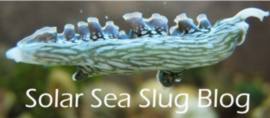Copepod Video
With no fish to eat them, and lots of detritus, the copepods have been proliferating. Here is the view this morning.


Bryopsis GONE. Slugs frisky.
It took them about 2 1/2 weeks, but the mass of Bryopsis is gone. The slugs consumed a lot, spending almost all of their time face down in the stuff, but some of the algae may have died due to my inability to keep NO3 and PO4 at measurable levels. I have been adding KH2PO4 and KNO3, but the plants have been consuming it like crazy.
Here is what the tank looks like now. Rather different from a week or so ago when it was stuffed with fresh algae.
A couple of them were chasing each other. Courtship? Will we finally see eggs?


What killed the amphipods?
I came into the office on Sunday to find hundreds of dead amphipods in the box of slugs. Because there is plenty of vegetable material and no predation, the amphipods had multiplied rapidly, but I was surprised at the sheer number of dead little bugs.
Naturally, I was anxious about the slugs, but they seemed unconcerned. In fact, none of the other inhabitants seemed at all bothered, including the corals.
Snails? Fine. They have been happily grazing away on the glass and other surfaces.
Isopods? Fine. If anything, they seemed more bold than usual. So, whatever it was did not affect all arthopods equally.
The sabellid worms that came in with the Bryopsis were also unaffected.
I learned later that there had been a power outage, which explains why the low-flow alarms for the fume hoods in the lab were ringing when I arrived Sunday. Perhaps the amphipods were more sensitive to the loss of circulation in the tank than were the other invertebrates. Maybe amphipods just don’t like big piles of Bryopsis. We may never know. Will the amphipod population rebound? We’ll see.
A few pounds of love
The Box of Slugs just got a little happier. They ate through the last batch of Bryopsis in less than a week, so it was time to increase supply and reduce demand. Justin, a WAMAS member with a 500 gallon tank and slight problem with Byopsis, offered a pile (read a few pounds) of algae. It seemed like a good idea to thin the herd at the same time, so I brought over three slugs to see if they could make a dent in his Bryopsis crop (bringing the population in the office tank to 8). Tangs, urchins and snails will not touch the stuff, but E. clarki likes it more than anything.
The office tank is pretty full of tasty green pest algae.
We’ll see how the little guys do in his tank. They looked so tiny going in. They should be happy as long as they stay away from the pumps.
Bryopsis Feast
Up to now, the slugs have had a number of macroalgae to sample from. This week, I obtained some sizable chunks of Bryopsis, and found out how much the little guys like it. They were all over it, and spent the next few days stuck like glue to the various patches.

Elysia clarki enjoying Bryopsis













Recent Comments